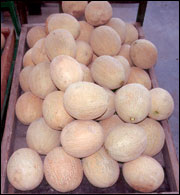High tunnels are low-cost, passive, solar plant forcing structures that use no fossil fuels for heating or venting (Figure 1). High tunnels can provide many benefits to horticulture crop producers:
- High tunnels are used to lengthen the growing season of crops.
- High tunnels protect the growing crop from environmental stress such as drought, driving rain, wind and temperature extremes.
- High tunnels protect crops from insect and disease infestation.
- High tunnels are well suited for producing heirloom and specialty vegetables that require a specific growing environment.
- High tunnels permit intensive crop production on a small area of land.
Many warm-season (frost-sensitive) vegetable crops can be grown in a high tunnel. Cucurbits are a large, diverse group of warm-season plants in the Cucurbitaceae family. Cucurbits include many popular vegetables such as cucumber, cantaloupe (muskmelon), squash, pumpkin, watermelon and gourd. Most are an important dietary source of fiber, minerals, beta-carotene and vitamin C.
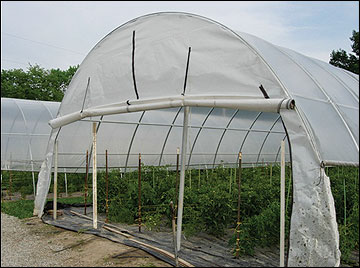 Figure 1.
Figure 1.
High tunnels are plastic-covered, solar plant forcing structures that can be used for early-season cucurbit production.
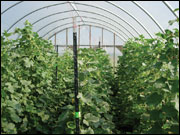
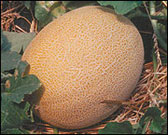
Table 1.
Groups of Cucumis melo.
| Cucumis melo subgroup | Cultivar examples | Fruit characteristics |
|---|---|---|
| Cantaloupensis (true cantaloupe) |
|
Smooth to warty fruit surface. Very aromatic. No netting. Fruits do not slip from vine when mature. Widely grown in Europe |
| Inodorus |
|
Not aromatic. Fruit does not slip from vine when mature. Flesh is usually green or white when mature. |
| Reticulatus |
|
Netted and aromatic fruit slips from the vine when mature. |
| Conomon |
|
No aroma. Fruit has crisp, white flesh. Widely grown in Asia. |
| Flexuosus |
|
Elongated fruit with no aroma. |
| Chito |
|
Fruit is not sweet or aromatic. |
| Dudaim |
|
Very aromatic fruit. |
Botany of melons and watermelons
Cantaloupe or muskmelon (Cucumis melo L.) and watermelon (Citrullis lanatus var. lanatus) are annual plants with a trailing vine growth. Cucumis melo has several botanical subgroups (Table 1). In the United States, reticulatus and inodorus are commercially grown, while the remaining groups are grown for niche or local markets.
The cantaloupe fruit that most Americans are familiar with is not actually a true cantaloupe. A true cantaloupe has no netting on the rind, is often warty, and many will not abscise or slip from the vine when mature (Figure 2). True cantaloupes are widely grown in Europe and include varieties such as Charentais, Prescott, D'Alger and Petit gris de Rennes.
A muskmelon (Cucumis melo var. reticulatus) has a pronounced netting on the fruit, is aromatic, and slips from the vine when mature (Table 1). Most wholesale markets prefer an oval to round muskmelon with medium to heavy netting and slight ribbing, while some local markets prefer lightly netted, deep-ribbed types. The terms muskmelon and cantaloupe are often used interchangeably in U.S. markets.
Galia melons are green-fleshed, aromatic muskmelons with a golden-yellow, netted rind (Figure 2). Galia melons are adapted to warm, dry climates and are often called desert melons. Rainfall during flowering and fruit formation significantly lowers the quality of Galia melons.
Watermelons are classified as seeded diploids or seedless triploids. Seedless watermelons have higher production costs but may be profitable as an early-season crop in a high tunnel. A seedless watermelon is a cross between a diploid seeded variety (two sets of chromosomes) with a tetraploid (breeding line having four sets of chromosomes). The plants from this cross have three sets of chromosomes and are sterile. Seedless cultivars must have pollen from a seeded, diploid cultivar to set fruit. In addition to having no seeds, seedless cultivars normally are very high in sugar content. Mini seedless watermelons (less than 6 pounds) are becoming popular with consumers as single-serving melons.
Melons and watermelon are second only to bananas in total U.S. per capita consumption of fresh fruit. Melons are low in fat and sodium, have no cholesterol, and provide many essential nutrients such as potassium. Watermelons are an excellent source of lycopene, a powerful antioxidant which might help to protect cells from damage and prevent various forms of cancer.
Both melons and watermelon are native to Africa and thrive in a warm, dry climate with a long growing season. The optimal growing temperature for melons and watermelons is 70 to 85 degrees Fahrenheit.
Cucurbits have palm-shaped leaves that are lobed (watermelon) or nonlobed (cantaloupe). Leaves are arranged in an alternate pattern on the vine. The vines are angular and hairy with several lateral branches that in turn have many secondary branches. Vines can reach a length of 30 feet for some cucurbit varieties.
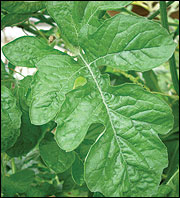
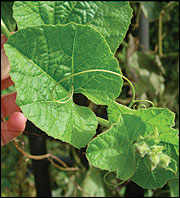 Figure 3.
Figure 3.
Watermelon leaves, left, are lobed with branched tendrils while muskmelon leaves, right, are nonlobed with simple tendrils at each leaf axis. Tendrils are used by the vines for climbing and anchoring.
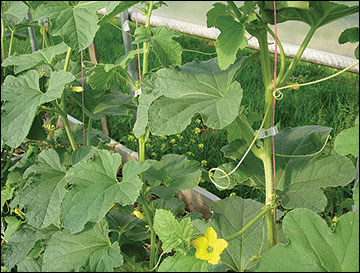
Melons and watermelons have modified, threadlike leaves called tendrils, which the vine uses for anchoring or climbing (Figure 3). Tendrils can be branched (watermelon) or simple (muskmelon). Both cucurbit crops have strong taproots that can be deep on non-irrigated melon crops but generally are shallow but horizontally extensive when the crop is adequately irrigated.
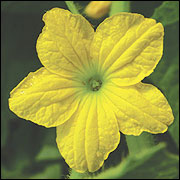
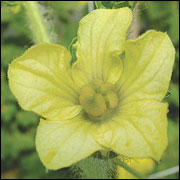 Figure 4.
Figure 4.
Melon flowers, left, are brighter yellow and yield more nectar than watermelon flowers.
Cucurbit flowers are diverse in color, shape and size (Figure 4). Cucurbits have a monoecious flowering pattern, which means male and female flowers are separate on each plant. Melons have male (staminate) flowers and a mix of female (pistillate) and perfect (both male and female organs) flowers. Watermelons typically have staminate and pistillate flowers. Staminate flowers appear first and are followed by emergence of more staminate and pistillate flowers. Generally, 12 to 15 staminate flowers are produced for each pistillate flower.
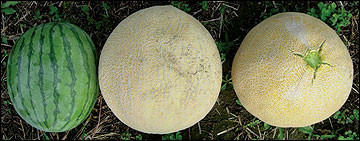 Figure 5.
Figure 5.
Mini seedless watermelons are similar in size to muskmelons (3 to 6 pounds).

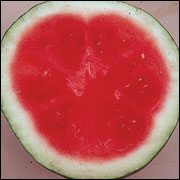
Cultivar selection
There are many productive cantaloupe and watermelon cultivars that can be grown in a high tunnel (Figure 5, Table 3). Choose a suitable cultivar for your market outlet. Purchase high-quality, vigorous seeds for transplant production. High-quality seeds mean faster germination and vigorous growth. One ounce of muskmelon seeds contains 950 to 1,200 seeds while one ounce of watermelon seeds contains 300 (large-seeded cultivars) to 650 (small-seeded cultivars) seeds (Table 2).
Table 3 includes suggested varieties of muskmelons, cantaloupes, honeydews and mini seedless watermelons for high tunnel production.
Table 3
Potential melon and mini watermelon cultivars for high tunnel production.
| Cultivar | Cucurbit type | Days to maturity | Fruit description | Disease tolerance* |
|---|---|---|---|---|
| Athena | Muskmelon | 80 | Oval/round fruit with minor netting and no sutures. |
PM 1, 2 F 0, 1, 2 |
| Aphrodite | Muskmelon | 75 | Oval, large fruit. Light sutures. |
PM 1, 2 F 0, 1, 2 |
| Ambrosia | Muskmelon | 86 | Round fruit. Coarse netting. Good garden cultivar. | PM |
| Crescent Moon | Muskmelon | 73 | Large, eastern-type melon. | PM 1, 2 |
| Jenny Lind | Muskmelon | 70 | Round fruit with heavy netting. Green or orange flesh. Large blossom scar. Heirloom melon. | |
| Odyssey | Muskmelon | 80 | Round, large fruit with coarse netting and shallow sutures |
PM 1, 2 F 0, 1, 2 |
| Primo | Muskmelon | 78 | Small, western-type shipping melon. Heavy netting | PM 1, 2 |
| Sugar Cube | Muskmelon | 80 | Intensely sweet. Heavily netted fruits. Softball size. |
F PM |
| Arava | Galia | 77 | Round fruit with green flesh. Light netting. | PM |
|
Galia 152 |
Galia | 80 | Round fruit with green flesh. Very aromatic. No sutures. |
PM 1, 2 F 0, 1, 2 |
|
Galileo |
Galia | 83 | Round fruit with green flesh. Light netting. |
PM 1, 2 F 0, 1, 2 |
| Gallicum | Galia | 80 | Round fruit with green flesh. Small fruit. |
PM 1, 2 F 0, 1, 2 |
|
Lavigal |
Galia | 80 | Round fruit with green flesh. Very aromatic. Light netting. |
PM 1, 2 F 0, 1, 2 |
|
Early Dew |
Honeydew | 80 | Round fruit. Very early, 2.5 to 3 pounds fruit which slips at maturity. |
PM 1, 2 F 0, 1 |
|
Honey Orange |
Honeydew | 74 | Oval fruit with orange flesh. |
PM 1, 2 F 0, 1 |
| Honey Star | Honeydew | 85 | Round fruit with light-green flesh. |
PM 1, 2 F 0, 1 |
| Savor | Charentais cantaloupe | 78 | Round, small fruit with dark orange flesh. Produces a vigorous vine that may need pruning |
PM F 0, 1, 2 |
| Watermelon (mini size) | ||||
| Jade Star | Mini seeded | 75 | Small, round, dark green drind | |
| Sweet Beauty | Mini seeded | 77 | Small, oblong, seeded watermelon | |
| Extazy | Mini seedless | 85 | Small, round | |
| Hazera 5130 | Mini seedless | 85 | Small, round | |
| Mohican | Mini seedless | 85 | Medium, green rind | |
| Solitaire | Mini seedless | 85 | Small, round | |
| Vanessa | Mini seedless | 80 | Solid, dark rind | |
*Disease tolerance key: PM = Powdery mildew race 0, 1, 2.
F = Fusarium wilt race 0, 1, 2.
Note
This list is not intended to include every cultivar that may perform well in a high tunnel.
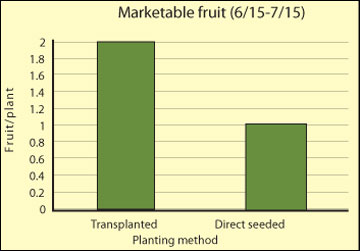 Figure 6.
Figure 6.
Transplants increase early yield of melons in a high tunnel.
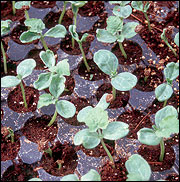
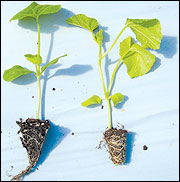 Figure 7.
Figure 7.
Use healthy, vigorous transplants for early melon and watermelon production in a high tunnel.
Transplant production
For early production in a high tunnel, melons and watermelons should be established as transplants. Transplants increase uniformity and earliness of the crop while reducing seed costs (Figure 6). Quality transplants begin with quality seeds. Choose a suitable cultivar and melon type that has consumer demand in your market outlet (Table 3).
Various containers can be used to germinate and grow cucurbit plants. Generally a transplant container or cell 1 to 2 inches in diameter is optimal for melon and watermelon. However, using a larger cell size may increase earliness. One seed can be placed in each container cell, one-half inch deep using a standard potting or germination mix. Seedless watermelon seeds are planted with the radicle tip pointed up or flat, which helps the seed shed the seed coat. After seeding, water the seeds and place in a warm room (85 to 90 degrees Fahrenheit) for about three days to accelerate germination. Do not overwater seedless triploids. Seedless watermelons should be germinated at 90 degrees for 48 hours. After 10 percent of the seeds have emerged, the temperature can be lowered to 70 to 80 degrees (day) and 65 to 70 degrees (night) for growth and development.
Depending on prevailing weather, transplants should be regularly watered. Watering should be done in the morning allowing leaves to dry before evening, which reduces the risk of disease. Three times a week, a 200 ppm nitrogen solution may be applied to the growing transplants (Table 4). Four to six weeks are required for growth of melon and watermelon transplants. One week before transplanting, reduce fertilization and watering to harden or condition the plants for transplanting within the high tunnel. A good melon or watermelon transplant should have two to four true leaves, short, thick stems and a healthy root system (Figure 7).
Table 4.
Ounces of fertilizer per 100 gallons of water.
| Fertilizer analysis | ||||
|---|---|---|---|---|
| Nitrogen | 20-20-20 |
9-45-15 |
15.5-0-0 | 15-30-15 |
| 100 ppm | 6.7 ounces dissolved in 100 gallons of water. | 14.8 ounces | 8.6 ounces | 8.9 ounces |
| 200 ppm | 13.3 ounces dissolved in 100 gallons of water. | 29.6 ounces | 17.2 ounces | 17.8 ounces |
| 300 ppm | 20.1 ounces dissolved in 100 gallons of water. | 44.4 ounces | 25.8 ounces | 26.7 ounces |
| 400 ppm | 26.6 ounces dissolved in 100 gallons of water. | 59.2 ounces | 34.4 ounces | 35.6 ounces |
| 500 ppm | 33.5 ounces dissolved in 100 gallons of water. | 74.0 ounces | 43.0 ounces | 44.5 ounces |
| 600 ppm | 40.2 ounces dissolved in 100 gallons of water. | 88.8 ounces | 51.6 ounces | 53.4 ounces |
Planting in the high tunnel
The soil within the high tunnel should be tilled, fertilized and formed into a raised bed before transplanting (Figure 8). Raised beds (4 to 6 inches high by 20 to 32 inches wide) increase the average soil temperature and improve root zone aeration and drainage while providing a larger volume of soil for root growth.
For early melon production, plastic mulch is more effective in warming the soil than organic mulches. Plastic mulch and drip irrigation should be applied to the raised beds at least two weeks before transplanting. There are several plastic mulches to choose from. Black plastic is the preferred plastic mulch for cucurbits because it warms the root zone and reduces both weed germination and soil moisture evaporation. The soil temperature during the daytime is about 5 degrees Fahrenheit warmer at the 2-inch depth under black plastic than in nonmulched, bare soil. Clear plastic mulch warms the soil more than black plastic but does not suppress weed germination. Infrared (IRT) mulch is intermediate between clear and black with the added benefit of reducing most weed emergence. Reflective or metallic mulches repel insects such as aphids but generally keep the soil cooler. White or white-on-black mulch is used to cool the soil and can be used for summer or fall cucurbit plantings within the high tunnel. All plastic mulch should fit tightly over the raised bed to maximize heat transfer from the mulch to the soil. Embossed plastic (embossed with a diamond-shape pattern) mulch fits tightly over the raised bed and expands and contracts without losing tautness. Transplants can be lost from heat necrosis that occurs when heat funnels out through the planting hole when the plastic mulch is not tightly fitted over the raised bed.
In a high tunnel, melons and watermelons are spaced 24 to 36 inches between plants within each row, and the rows are spaced 40 to 48 inches on center. On a square foot basis, this is nearly double the plant density of field-grown melons and watermelons. The ability to grow the plants vertically by trellising and the dry (no rain) environment make higher plant populations feasible within a high tunnel. Thus, a commercial high tunnel (2,500 square feet) can accommodate 200 to 300 cantaloupe or watermelon plants.
Each transplant is planted about 1 to 2 inches deeper than the surface of the transplant root ball. The planting hole on the plastic mulch can be perforated by hand or using a bulb planter. Immediately after transplanting, a starter fertilizer solution containing nitrogen (200 to 400 ppm) and phosphorus should be applied to each transplant to reduce transplant shock.
Planting date varies with geographical region. Soil temperature is a reliable index for determining when to plant within a high tunnel. Melons and watermelons can be transplanted when the soil temperature at the 2-inch depth is at least 60 degrees Fahrenheit.
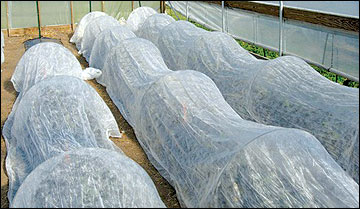 Figure 9.
Figure 9.
Row covers protect melons from frost damage and chilling injury.
Row covers
Row covers are used to increase the average minimum temperature within the crop canopy. There are two types of row covers. One type is polyethylene plastic with perforated holes for ventilation; the other type is a spunbonded fabric. Spunbonded row covers (0.5 to 1.25 ounces per square yard) are recommended for high tunnel Cucurbit production (Figure 9). Unlike polyethylene row covers, spun bonded row covers do not produce extremely high air temperatures during the daytime and are more effective at retaining heat for frost protection during the night. In addition, spunbonded row covers are lightweight, which makes them easy to place on or remove from the crop canopy.
Row covers should be applied immediately after transplanting in the spring and can be kept over the crop for several weeks depending on temperature within the high tunnel. In Missouri, row covers are left on the plants for about three weeks and are removed when the melons and watermelons begin to flower in mid-April. They are not completely removed from the high tunnel but held in reserve if frost or freeze threatens the crop.
Soil management and fertilization
Before planting cucurbits within a high tunnel, the soil should be sampled and analyzed to determine pH, organic matter content and nutrient levels. The optimal pH range for cantaloupes and watermelons is 6.0 to 6.8. If the soil pH is below optimum, liming may be performed. If necessary, lime should be applied as far in advance of transplanting as possible.
Before transplanting, 7 to 11 ounces of nitrogen per 1,000 square feet should be applied to the raised beds. Based on a soil test, all the required phosphorus and half of the required potassium should be applied before transplanting and mulch application. If the soil within the high tunnel is high in organic matter (at least 3 percent), a lower rate of preplant nitrogen can be applied. Thoroughly incorporate the fertilizer in the top 4 to 6 inches of the soil. Applying water-soluble fertilizer through the irrigation system is referred to as fertigation. If no fertilizer is applied before planting, fertigation should begin immediately after transplanting in the high tunnel. However, if preplant fertilizer is applied, fertigation can be delayed for two weeks. Fertilizer can be applied through the drip irrigation system over the remaining 10- to 12-week growing season. Table 5 gives a suggested fertigation program for high tunnel melons and watermelons. If preplant potassium is applied, potassium fertigation commences three weeks after transplanting. Adequate potassium fertilization is crucial for melon crops because potassium is correlated with melon sweetness.
Fertilization rates should be based on the total effective mulched area. Measure the width of the raised bed covered with plastic, and multiply by the row length. This product is multiplied by the number of rows within the high tunnel, which equals the total effective mulched area per high tunnel.
Table 5.
Suggested nitrogen and potassium fertigation schedule for high tunnel melons and watermelons.
| Days after transplanting | Weekly nitrogen | Weekly potassium, assuming a low soil potassium level (K2O) | Cumulative nitrogen |
|---|---|---|---|
| Preplant | 9.2 ounces per 1,000 square feet | 18.4 ounces per 1,000 square feet | 9.2 ounces per 1,000 square feet |
| 14 to 21 | 2.3 ounces per 1,000 square feet | 0 | 11.5 ounces per 1,000 square feet |
| 22 to 49 | 3.3 ounces per 1,000 square feet | 6.7 ounces per 1,000 square feet | 24.7 ounces per 1,000 square feet |
| 50 to 77 | 3.9 ounces per 1,000 square feet | 7.7 ounces per 1,000 square feet | 40.3 ounces per 1,000 square feet |
| 77 to 84 | 1.8 ounces per 1,000 square feet | 3.6 ounces per 1,000 square feet | 42.1 ounces per 1,000 square feet |
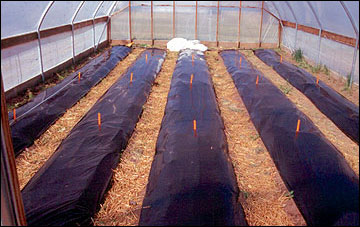
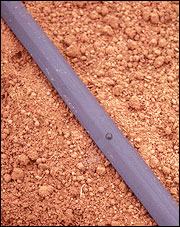
Figure 10.
Drip irrigation and black plastic mulch improve melon and watermelon yield and quality.
Irrigation of melons and watermelons
Because high tunnels exclude natural rainfall, the water requirements of the crop must be supplied by drip irrigation. Drip irrigation is a method of applying water slowly to the root zone of the growing crop by using small, collapsible tubes called drip tape (Figure 10). Drip irrigation has many advantages, including less water use and the ability to supply nutrients to the crop over the course of the growing season. Drip irrigation also helps the crop to grow evenly, reduces weed emergence and keeps the foliage dry, which prevents many diseases.
One drip line (8 to 10 mil thickness; 4-to-12 inch dripper spacing) is placed 3 inches from the center of the bed. The drip line should be buried 1 inch to prevent damage by mice and expansion and contraction of the tube during the growing season. Lateral movement of water from the drip tube may be about 10 to 12 inches on either side of the tube in heavy soils and 8 to 10 inches in light soils.
Irrigation can be scheduled based on using a soil moisture sensor (tensiometer or moisture blocks) or systematically applying an even quantity of water each week. Tensiometers work effectively in sandy soils, while gypsum blocks are effective in heavy soils.
Generally, one inch of water (per acre equivalent) is applied to melons and watermelons each week. During periods of hot weather and a heavy fruit load, 1.5 inches per week may be applied. For example, if a grower is using a medium-flow drip tape with a flow rate of 0.40 gpm per 100 feet, and the mulched row width is 30 inches, the crop should be irrigated 6.5 hours per week to deliver one inch of water to the crop (Table 6). Because plastic mulch reduces soil moisture evaporation, it is important not to overwater the crops. Excessive irrigation during the latter stages of fruit ripening can lower sugar levels and cause fruit cracking.
Table 6.
Hours required to apply 1 inch of water to a mulched, raised bed.
| Drip tube flow rate | Width of mulched bed | |||
|---|---|---|---|---|
| Gallons of water per hour per 100 feet run of drip tape | Gallons of water per minute per 100 feet run of drip tape | 2 feet | 2.5 feet | 3 feet |
| 8 | 0.13 | 15.5 | 19.5 | 23.5 |
| 10 | 0.17 | 12.5 | 16.5 | 18.5 |
| 12 | 0.20 | 10.5 | 13.0 | 15.5 |
| 16 | 0.27 | 8.0 | 10.0 | 11.5 |
| 18 | 0.30 | 7.0 | 8.5 | 10.5 |
| 20 | 0.33 | 6.0 | 8.0 | 9.5 |
| 24 | 0.40 | 5.0 | 6.5 | 8.0 |
| 30 | 0.50 | 4.0 | 5.0 | 6.0 |
| 36 | 0.60 | 3.5 | 4.5 | 5.0 |
| 40 | 0.67 | 3.0 | 4.0 | 4.5 |
| 42 | 0.70 | 3.0 | 4.0 | 4.5 |
| 48 | 0.80 | 2.5 | 3.0 | 4.0 |
Pollination
Melons and watermelons have separate male and female flowers on each vine. Male flowers appear at least a week earlier than female flowers. Female flowers are easy to distinguish from male flowers by the presence of a swollen base below the flower petals (Figure 11A). Flowers open after sunrise and remain open for only one day. Since melon and watermelon pollen is heavy and sticky, it does not move with wind currents. Thus, physical movement of pollen is necessary before a fruit is set on the vine. Pollination of the first flush of female flowers is crucial because these flowers can develop into large, early fruit.
Nectar-collecting bees (honey bees, bumble bees, solitary bees and mason bees) are common vectors of cucurbit pollen. Research has revealed that each female melon flower must receive at least eight bee visits to set a marketable fruit. Research at MU has revealed that having sufficient bees for pollination will increase average fruit weight of muskmelons within a high tunnel. Bumble bees (Bombus impatiens) can be purchased and placed within each high tunnel two to three weeks after transplanting. Use insect screen to retain the bees within the high tunnel. Honey bee colonies can be placed close to the high tunnel to encourage entry. Planting high nectar yielding plants such as Brassica sp. (mustards) close to the high tunnel may increase native bee density within a high tunnel. Melons that are poorly pollinated are smaller while improperly pollinated watermelons are often lopsided or bottlenecked.
If feasible, hand pollination of cucurbits may be performed. In midmorning select a recently opened male flower. Carefully remove the petals surrounding the male stamens (pollen-producing organs). Identify a recently opened female flower, and gently brush the stamens against the flower 10 to 15 times. Research indicates that hand pollination is most effective between 6:00 and 9:00 a.m. Hand pollination requires patience and may be effective only 50 percent of the time.
Seedless watermelons produce sterile pollen and thus require pollen from a seeded cultivar before setting fruit. A seeded cultivar can be planted as a single row parallel to the baseboards of the high tunnel. Alternatively, the seeded cultivar can be interplanted with the seedless cultivar with every third plant within the row a seeded cultivar. Icebox watermelon cultivars (7 to 10 pounds fruit) are effective pollen producers for early yield of seedless watermelons. It is important to synchronize appearance of male flowers on the pollenizing cultivar with female flower opening on the seedless cultivar. The icebox pollenizer should be seeded seven to ten days later than the seedless watermelon cultivar, since they flower earlier than most watermelon cultivars. If a standard-sized seeded melon is used as a pollenizer, it should be seeded three to four days before the seedless watermelons are seeded. Watermelons and melons will not cross-pollinate when grown within the same high tunnel.
Pruning of melons and watermelons
Many melon cultivars produce extensive vine growth. Pruning the vines may be necessary if the melons are trellised. Pruning is performed to achieve a balance between vine growth and fruit set. Pruning increases average fruit weight while reducing the number of unmarketable (cull) fruit.
Each melon vine produces a primary stem or leader with many secondary branches or laterals. A suitable pruning treatment for high tunnel muskmelons to retain the primary stem and one of the first laterals while pruning all additional laterals up to and including the eighth leaf node. All secondary branches after the eighth node can be left unpruned on the plant. This method of pruning permits the vine to be easily trellised either by a nylon net trellis or by using strings and vine clips as in greenhouse tomato production. Prune off any misshapen fruits or fruits that were not pollinated.
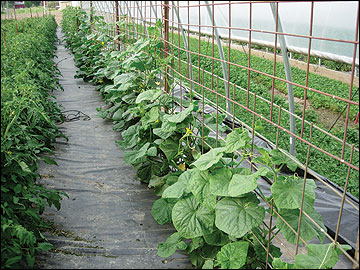 Figure 12.
Figure 12.
Trellising increases marketable yields of high tunnel melons.
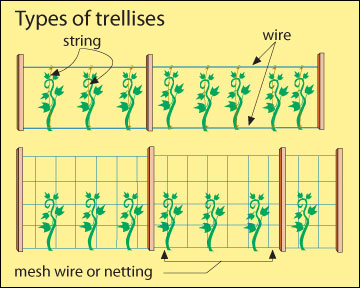
Trellising of melons and watermelons
Training melons and watermelons to grow vertically is referred to as trellising and is one of the advantages of growing melons in a high tunnel. Most melon cultivars and personal size (less than 7 pounds) watermelon cultivars are amenable to trellising. Trellising improves light interception by the crop canopy, makes harvest easier, improves pollination and reduces damage to the vines during harvest. Trellising is necessary if the high tunnel is used to grow crops in addition to melons, since melon vines will overrun other plants if not trained.
Various types of trellises can be used for high tunnel melons and watermelons (Figure 12). Using a trellis with a plastic (nylon) net (6-inch by 7-inch openings) that is about 72 inches high is a suitable trellis for pruned and unpruned vines. The trellis must be supported by a tensile wire of adequate strength, which runs parallel to the row and slightly higher than the trellis. This wire can be secured to the frame of the high tunnel or attached to posts at each end of the row. The mesh trellis is in turn secured to the wire. The vines gradually grow up the trellis, using their tendrils to cling to the mesh trellis, but they will require training to keep the growth vertical. Assume the static load on the wire will be about 10 to 12 pounds per linear foot.
Another form of trellis is an option when each vine has been pruned to one or two stems. Tie a length of nylon twine to a tensile wire 6 to 7 feet off the ground and secure it to the ground using anchor pins. The primary stem of the muskmelon plant is secured to the twine using plastic vine clips. As the vine continues to grow, it is clipped to the vertical twine. If the vine grows taller than the height of the trellis, it can be trained from the top down on another length of twine. Woven wire fence or livestock panels can also be used as a trellis for cucurbits.
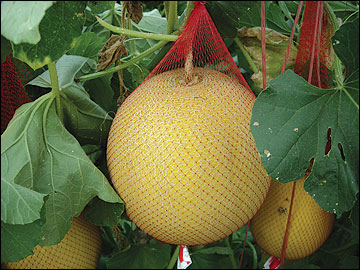 Figure 13.
Figure 13.
Mesh bags tied to a trellis protect and support melons as they ripen.
Fruit may require support as it grows on the trellis. Some muskmelon cultivars have fruit with rigid peduncles (fruit stems) and may not need support. Small, mesh bags (onion sacks), cheesecloth or nylons can be used as slings to support the fruit (Figure 13). The bags can be tied to the trellis or the support wire. The bag should allow light penetration and not hold moisture. When the fruit is ripe, the bag can be cut from the trellis.
Mini seedless (or seeded) watermelons can be trellised in a high tunnel. If so, the fruit must be supported. Other types of watermelons (large, seeded or seedless) normally are grown without a trellis and left to vine throughout the high tunnel.
Table 7.
Average yields of cantaloupes and mini seedless watermelons within a high tunnel located in mid-Missouri.
| Melon type | Average market yield per plant | 1Average market yield per high tunnel |
|---|---|---|
| Galia | 3 to 5 melons | 900 to 1,500 melons |
| Charentais | 3 to 4 melons | 900 to 1,200 melons |
| Athena | 2 to 3 melons | 600 to 900 melons |
| Micro seedless watermelon | 2 melons | 600 melons |
1Assumes a high tunnel with 300 melon or watermelon plants.
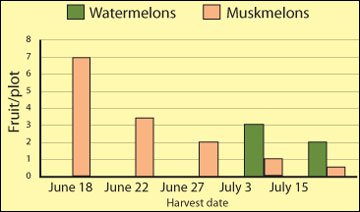 Figure 14.
Figure 14.
Marketable yield of Galia muskmelon and mini seedless watermelon. Each plot contained four plants.
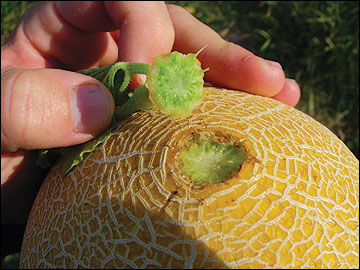
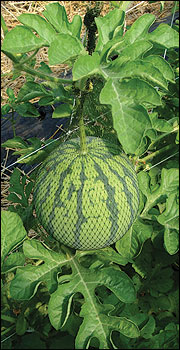 Figure 15.
Figure 15.
Muskmelons slip from the vine when mature. In contrast, watermelons do not slip and are harvested when the endril closest to the fruit dries.
Harvest and yield
Melons have several yield flushes requiring harvest three to four times a week during peak production, while watermelons tend to ripen evenly and the bulk of the fruit can be harvested in relatively few harvests (Figure 14). Melon and watermelon fruit are ready to harvest 45 to 60 days after flowering. Research at MU has shown that Galia muskmelons are very high yielding when grown in a high tunnel (Table 7). Muskmelons yield more fruit per plant than watermelons in a high tunnel. Melon harvest in a high tunnel is four to five weeks earlier than field-grown melons and watermelons in Missouri.
Muskmelons develop a distinct abscission zone between the fruit stem and the fruit (Figure 15). As muskmelon fruit ripens, the color changes from green to yellow, and the fruit produces an aromatic odor on the blossom end. On some cultivars, the netting becomes more pronounced at maturity. High tunnel muskmelons for local markets should be harvested vine ripe or "full slip," the stage at which the fruit detaches from the vine with slight pressure. To prevent overripening, Galia melons should be harvested when the fruit changes color to a bright yellow. Galia melons produce a strong floral odor and easily detach from the stem. Muskmelons will ripen after harvest, but the sugar content does not increase. The sweetness should be at least 11 degrees Brix, and the fruit should weigh 3 pounds or more. Specialty melons can be sold at a smaller weight (1 to 2 pounds).
Charentais melons and honeydew melons do not slip from the vine at maturity, and honeydews do not produce an aroma as they ripen. Charentais fruit will change color from a gray/green to creamy white. The leaves closest to the fruit stem will also begin to develop a pale color. The fruit must be harvested before it begins to split. Ripe melons can be stored for almost two weeks at 34 degrees Fahrenheit and 95 percent relative humidity. Honeydew melons and other specialty melons should be stored at 45 degrees and 90 percent relative humidity.
Watermelons do not slip from the vine or emit an odor when ripening. Other indicators of maturity include increased "waxiness" of the rind, drying of the tendril closest to the fruit and a dull, muffled sound when the watermelon is thumped, depending on the variety. Watermelons should be cut from the vine rather than pulled, leaving about an inch of stem. The stem can be trimmed on the day of sale, giving the melons a fresh harvest appearance. Harvest early in the morning when field heat is low and the fruits are most turgid. Watermelon sweetness should be at least 11 degrees Brix. Watermelons should be stored at 50 to 60 degrees Fahrenheit and 90 percent relative humidity.
Marketing
Demand for melons and watermelons is increasing. Muskmelons are sold individually at farmers' markets (Figure 16). Most wholesale markets sell melons in corrugated bins or 1-3/4-bushel boxes that contain 15 to 18 melons per box and weigh about 60 pounds. Muskmelons weighing more than 6 pounds are considered large; medium-size melons weigh 4 to 6 pounds and small melons weigh less than 4 pounds. Watermelons are sold individually or in bins containing about 60 watermelons. Use only clean bins or boxes for packing melons and watermelons.
Pest management
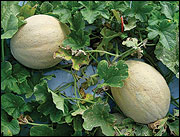 Athena muskmelon.
Athena muskmelon.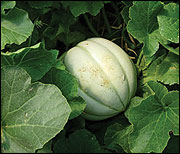 Charentais cantaloupe.
Charentais cantaloupe. Personal-size (mini) seedless watermelons.
Personal-size (mini) seedless watermelons.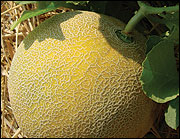 Galia muskmelon.
Galia muskmelon.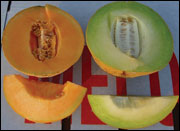 Comparison of Athena, left, and Galia 152 muskmelon flesh color.
Comparison of Athena, left, and Galia 152 muskmelon flesh color.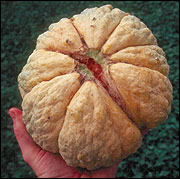 Prescott cantaloupe.
Prescott cantaloupe.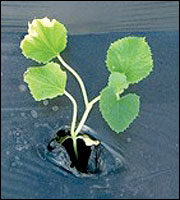

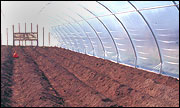
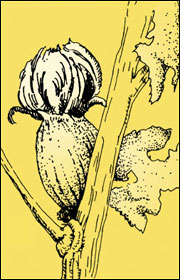 Note the swelling at base of the flower. This will develop into a fruit. Cantaloupe can produce two types of flowers.
Note the swelling at base of the flower. This will develop into a fruit. Cantaloupe can produce two types of flowers.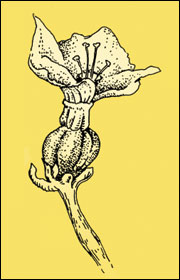 Perfect flowers having both male and female parts.
Perfect flowers having both male and female parts.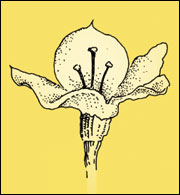 Staminate flowers having only male parts.
Staminate flowers having only male parts.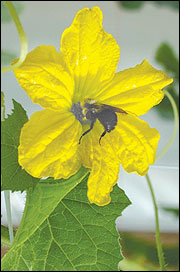 Figure 11.
Figure 11.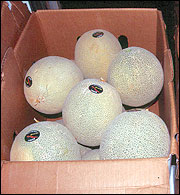 Figure 16.
Figure 16.